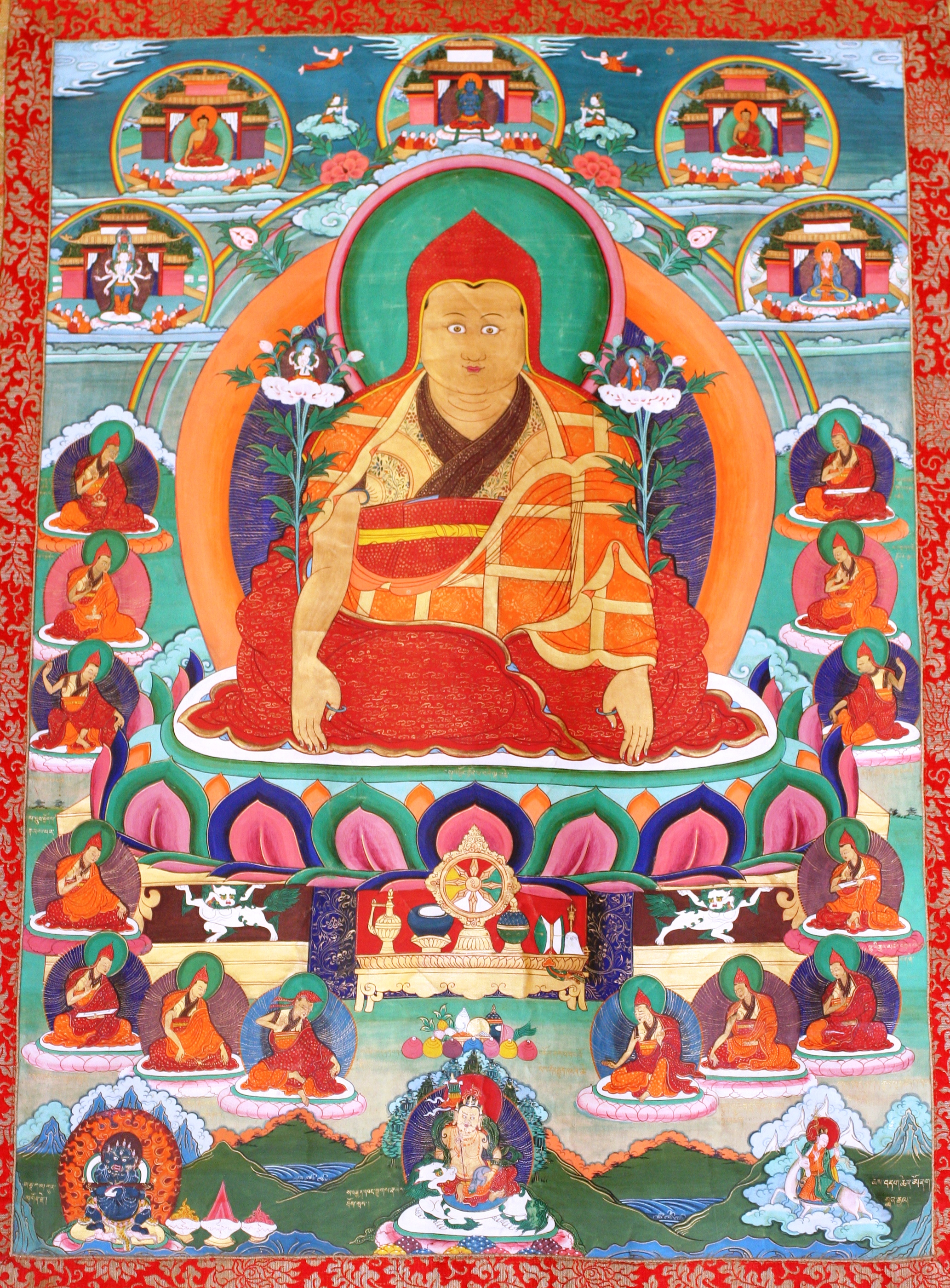|
TathńĀgatagarbha SŇętra
The ''TathńĀgatagarbha SŇętra'' is an influential and doctrinally striking MahńĀyńĀna Buddhist scripture which treats of the existence of the " TathńĀgatagarbha" (Buddha-Matrix, Buddha-Embryo, lit. "the womb of the thus-come-one") within all sentient creatures. According to the Buddha, all sentient beings are born with buddha-nature and have the potential to become a Buddha. Physical and mental defilements of everyday life act as clouds over this nature and usually prevent this realization. This nature is no less than the indwelling Buddha himself. History Origins and development Anthony Barber associates the development of the ''TathńĀgatagarbha SŇętra'' with the MahńĀsńĀŠĻÉghika sect of Buddhism, and concludes that the MahńĀsńĀŠĻÉghikas of the ńÄndhra region (i.e. the Caitika schools) were responsible for the inception of the TathńĀgatagarbha doctrine. The ''TathńĀgatagarbha SŇętra'' is considered "the earliest expression of this he tathńĀgatagarbha doctrineand the term ''tat ... [...More Info...] [...Related Items...] OR: [Wikipedia] [Google] [Baidu] |
Luminous Mind
Luminous mind ( Skt: or , Pali: ; Tib: ; Ch: ; Jpn: ) is a Buddhist term that appears only rarely in the Pali Canon, but is common in the Mahayana sŇętras and central to the Buddhist tantras. It is variously translated as "brightly shining mind" or "mind of clear light", while the related term ''luminosity'' (Skt. ; Tib. ; Ch. ; Jpn. ; Kor. ) is also translated as "clear light" or "luminosity" in Tibetan Buddhist contexts or " purity" in East Asian contexts. The Theravada school identifies the "luminous mind" with the '' bhavanga'', a concept first proposed in the TheravńĀda Abhidhamma. The later schools of the Mahayana identify it with '' bodhicitta'' and '' tathagatagarbha''. The luminosity of mind is of central importance in the philosophy and practice of the Buddhist tantras, Mahamudra, and Dzogchen. Early Buddhist texts The Early Buddhist Texts contain mentions of luminosity or radiance that refer to the development of the mind in meditation. In the ''SaŠĻÖgńę ... [...More Info...] [...Related Items...] OR: [Wikipedia] [Google] [Baidu] |
KulayarńĀja Tantra
The ''KulayarńĀja Tantra'' ( Tibetan phonetically: ''Kunjed Gyalpo'', ; English: "All-Creating King", or "Supreme Source") is a Buddhist Tantra in the Tibetan language and the principal Mind Series (Wylie: ''sems sde'') text of the Dzogchen (Great Perfection) tradition of the Nyingma school. The ''Kunjed Gyalpo'' contains within it smaller Dzogchen texts (from the earlier 18 ''semde'' texts) such as the ''Cuckoo of Rigpa (Rig pa'i khu byug)'' which appears in the thirty first chapter, as such it appears to be a sort of compilation of earlier Dzogchen literature (which is now categorized as "semde")''.'' The ''Kunjed Gyalpo'' is the main tantra of the early Great Perfection tradition during the " Era of Fragmentation" (9th‚Äď10th centuries) period. As such, it is a key source for the early teachings of Dzogchen, before the developments of the Tibetan renaissance period (11th -12th centuries) transformed Dzogchen into its later (and currently dominant) forms, mainly the Mennga ... [...More Info...] [...Related Items...] OR: [Wikipedia] [Google] [Baidu] |
Hongaku
The moon reflected in water is a popular simile for enlightenment used by DŇćgen in the '' East Asian Buddhist doctrine often translated as "inherent", "innate", "intrinsic" or "original" enlightenment in Buddhism">awakeness. This doctrine holds all sentient beings are already enlightened or awakened in some way. In this view, since all beings have some kind of awakeness as their true nature, the attainment of insight is a process of discovering and recognizing what is already present, not of attaining some goal or developing a potential.Stone, Jacqueline. 'From Buddha Nature to Original Enlightenment: "Contemplating Suchness" in Medieval Japan' in Mathes, Klaus-Dieter, and Casey Kemp, eds. ''Buddha Nature Across Asia''. Wiener Studien zur Tibetologie und Buddhismuskunde 103. Vienna: Arbeitkreis f√ľr tibetische und buddhistische Studien, University of Vienna, 2022. As such, people do not have to become Buddhas through religious cultivation, they just have to recognize that they ... [...More Info...] [...Related Items...] OR: [Wikipedia] [Google] [Baidu] |
Dolpopa Sherab Gyaltsen
D√∂lpopa Sh√©rap Gyeltsen () (1292‚Äď1361),Newland (1992). p. 29 known simply as D√∂lpopa, was a Tibetan Buddhist master. Known as "The Buddha from D√∂lpo," a region in modern Nepal, he was the principal exponent of the shentong teachings, and an influential member of the Jonang tradition of Tibetan Buddhism. Biography D√∂lpopa was born in D√∂lpo. In 1309, when he was seventeen, he ran away from home to seek the Buddhist teachings, first in Mustang and then in Tibet. In 1314, when he was twenty-two years old, D√∂lpopa received full monastic ordination from the famous abbot of Choelung Monastery, S√∂nam Trakpa (1273‚Äď1352), and made a vow at the time to never eat slaughtered meat again. In 1321, D√∂lpopa visited Jonang Monastery at Jomonang (which was later destroyed during the Cultural Revolution) for the first time. He then visited Tsurphu Monastery for the first time and had extensive discussions with Rangjung Dorje, 3rd Karmapa Lama, about doctrinal issues. It appea ... [...More Info...] [...Related Items...] OR: [Wikipedia] [Google] [Baidu] |
Dhammakaya Tradition
The Dhammakaya tradition or Dhammakaya movement (sometimes spelled Thammakaai) is a Thai Buddhist tradition founded by Luang Pu Sodh Candasaro in the early 20th century. It is associated with several temples descended from Wat Paknam Bhasicharoen in Bangkok. The tradition is distinguished from other Thai Buddhist traditions by its teachings on the Buddhist concept of '' Dhammakaya'' and the practice of Dhammakaya meditation (''Vijja Dhammakaya''), a method which scholars have connected to the Yogavacara tradition, which predates the 19th-century reform of Thai Buddhism. The Dhammakaya tradition is known for its teaching that there is a "true self" connected with Nirvana, which was notably criticized in the 1990s as an alleged contradiction of the Buddhist doctrine of ''anattńĀ'' (not-self). The Dhammakaya tradition is seen by its followers as a form of Buddhist revivalism pioneered by Luang Pu Sodh Candasaro. Buddhist Studies scholars have described aspects of its practices a ... [...More Info...] [...Related Items...] OR: [Wikipedia] [Google] [Baidu] |
Brahman
In Hinduism, ''Brahman'' (; IAST: ''Brahman'') connotes the highest universal principle, the ultimate reality of the universe.P. T. Raju (2006), ''Idealistic Thought of India'', Routledge, , page 426 and Conclusion chapter part XII In the Vedic Upanishads, ''Brahman'' constitutes the fundamental reality that transcends the duality of existence and non-existence. It serves as the absolute ground from which time, space, and natural law emerge. It represents an unchanging, eternal principle that exists beyond all boundaries and constraints. Because it transcends all limitation, ''Brahman'' ultimately defies complete description or categorization through language. In major schools of Hindu philosophy, it is the non-physical, efficient, formal and final cause of all that exists.For dualism school of Hinduism, see: Francis X. Clooney (2010), ''Hindu God, Christian God: How Reason Helps Break Down the Boundaries between Religions'', Oxford University Press, , pages 51‚Äď58, 11 ... [...More Info...] [...Related Items...] OR: [Wikipedia] [Google] [Baidu] |
Monism
Monism attributes oneness or singleness () to a concept, such as to existence. Various kinds of monism can be distinguished: * Priority monism states that all existing things go back to a source that is distinct from them; e.g., in Neoplatonism everything is derived from The One. In this view only the One is ontologically fundamental or prior to everything else. * Existence monism posits that, strictly speaking, there exists only a single thing, the universe, which can only be artificially and arbitrarily divided into many things. * Substance monism asserts that a variety of existing things can be explained in terms of a single reality or substance. Substance monism posits that only one kind of substance exists, although many things may be made up of this substance, e.g., matter or mind. * Dual-aspect monism is the view that the mental and the physical are two aspects of, or perspectives on, the same substance. * Neutral monism believes the fundamental nature of reality to be ... [...More Info...] [...Related Items...] OR: [Wikipedia] [Google] [Baidu] |
Soteriology
Soteriology (; ' "salvation" from wikt:ŌÉŌČŌĄőģŌĀ, ŌÉŌČŌĄőģŌĀ ' "savior, preserver" and wikt:őĽŌĆő≥őŅŌā, őĽŌĆő≥őŅŌā ' "study" or "word") is the study of Doctrine, religious doctrines of salvation. Salvation theory occupies a place of special significance in many religions. In the academic field of Religious studies, soteriology is understood by scholars as representing a key theme in a number of different religions and is often studied in a Comparative religion, comparative context; that is, comparing various ideas about what salvation is and how it is obtained. Buddhism Buddhism is devoted primarily to Enlightenment in Buddhism, awakening or enlightenment (''bodhi''), ''Nirvana (Buddhism), NirvńĀŠĻáa'' ("blowing out"), and Moksha, liberation (''vimokŠĻ£a'') from DuŠł•kha, all causes of suffering (''duŠł•kha'') due to the existence of Sentient beings (Buddhism), sentient beings in ''SaŠĻÉsńĀra (Buddhism), saŠĻÉsńĀra'' (the cycle of compulsory Rebirth (Buddhism), birth, death, ... [...More Info...] [...Related Items...] OR: [Wikipedia] [Google] [Baidu] |
ŇõŇęnyatńĀ
''ŇöŇęnyatńĀ'' ( ; ; ), translated most often as "emptiness", " vacuity", and sometimes "voidness", or "nothingness" is an Indian philosophical concept. In Buddhism, Jainism, Hinduism, and other Indian philosophical traditions, the concept has multiple meanings depending on its doctrinal context. It is either an ontological feature of reality, a meditative state, or a phenomenological analysis of experience. In TheravńĀda Buddhism, ' often refers to the non-self (PńĀli: ', Sanskrit: ') nature of the five aggregates of experience and the six sense spheres. ' is also often used to refer to a meditative state or experience. In MahńĀyńĀna Buddhism, ' refers to the tenet that "all things are empty of intrinsic existence and nature ('' svabhava'')", but may also refer to the Buddha-nature teachings and primordial or empty awareness, as in Dzogchen, Shentong, or Chan. Etymology ''ŇöŇęnyatńĀ'' is usually translated as "devoidness", "emptiness", "hollow", "hollowness", "v ... [...More Info...] [...Related Items...] OR: [Wikipedia] [Google] [Baidu] |
ńÄtman (Buddhism)
ńÄtman (), attńĀ or attan in Buddhism is the concept of self, and is found in Buddhist literature's discussion of the concept of non-self ('' Anatta''). Most Buddhist traditions and texts reject the premise of a permanent, unchanging ''atman'' (self, soul). 'Anatta, Encyclop√¶dia Britannica (2013), Quote: "Anatta in Buddhism, the doctrine that there is in humans no permanent, underlying soul. The concept of anatta, or anatman, is a departure from the Hindu belief in atman (‚Äúthe self‚ÄĚ)."; '' Steven Collins (1994), Religion and Practical Reason (Editors: Frank Reynolds, David Tracy), State Univ of New York Press, , p. 64; Quote: "Central to Buddhist soteriology is the doctrine of not-self (Pali: anattńĀ, Sanskrit: anńĀtman, the opposed doctrine of ńĀtman is central to Brahmanical thought). Put very briefly, this is the uddhistdoctrine that human beings have no soul, no self, no unchanging essence."; '' Dae-Sook Suh (1994), Korean Studies: New Pacific Currents, University of Ha ... [...More Info...] [...Related Items...] OR: [Wikipedia] [Google] [Baidu] |





